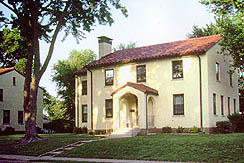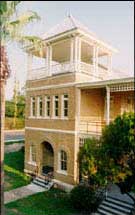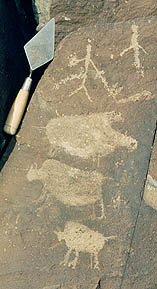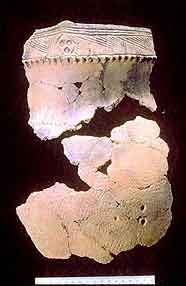 About ACHP
About ACHP ACHP News
National Historic
Preservation
Program
Working with
Section 106
Federal, State, & Tribal Programs
Training & Education
Publications
Search
Home
U.S. Army
Historic Preservation Program
Army Cultural Resource Management Program: Policy and Regulations
Interagency Agreement Between the Army and ACHP
Army Alternate Procedures Available for Implementation
Federal Preservation Officer and Contact
ACHP Staff Point of Contact for Policy and Program Issues
Army Cultural Resource Management Program:
Policy and Regulations
 Innovative policies, programs, and initiatives establish the Department of the
Army as a leader in cultural resources management. In 1994, the Secretary of the
Army created the Director of Environmental Programs (DEP) and the U.S. Army Environmental
Center (AEC) to support the Assistant Chief of Staff for Installation Management
and to administer the Department of the Army environmental program.
Innovative policies, programs, and initiatives establish the Department of the
Army as a leader in cultural resources management. In 1994, the Secretary of the
Army created the Director of Environmental Programs (DEP) and the U.S. Army Environmental
Center (AEC) to support the Assistant Chief of Staff for Installation Management
and to administer the Department of the Army environmental program.
AEC supports the DEP by providing Army-wide technical support and oversight services to execute the Army cultural resources management program. The DEP is responsible for promulgating cultural resources policy and guidance. Furthermore, the Army continues to build a significant cultural resources infrastructure that includes qualified cultural resources personnel at many installations.
The Department of the Army's official policy for management, care, and preservation of cultural resources is established in Army Regulation 200-4: Cultural Resources Management (AR 200-4). AR 200-4 establishes broad preservation and operational policies for the Army by addressing the requirements of all major cultural resources laws, regulations, Executive Orders, and Presidential memoranda. In reference to 36 CFR Part 800, AR 200-4 establishes internal Army policy for compliance with ACHP's regulations and is not designed to replace the Section 106 compliance procedures set forth in 36 CFR Part 800.
 To implement internal Army policy established in AR 200-4, the Army has developed
a detailed guidance document, Department
of the Army Pamphlet 200-4: Cultural Resources Management (DA PAM 200-4).
DA PAM 200-4 contains "nuts and bolts" information and guidance on how to fulfill
the requirements of the major cultural resources laws and regulations.
To implement internal Army policy established in AR 200-4, the Army has developed
a detailed guidance document, Department
of the Army Pamphlet 200-4: Cultural Resources Management (DA PAM 200-4).
DA PAM 200-4 contains "nuts and bolts" information and guidance on how to fulfill
the requirements of the major cultural resources laws and regulations.
Moreover, DA PAM 200-4 emphasizes the need for integrated cultural resources management—this is a "cultural landscape" approach to planning and management, whereby the military installation is viewed as an integrated landscape of natural and cultural resources and processes including military operations. Rather than a strictly compliance-driven approach to cultural resource management, the Army is moving towards a comprehensive integrated planning approach.
 In addition to AR 200-4 and DA PAM 200-4, the Army has developed a number of internal
Army-wide cultural resources guidelines and standards. The Army's Guidelines
for Consultation with Native Americans (Appendix F of DA PAM 200-4) provide
installation commanders and staff with information on developing effective communication
with Indian tribes and Native Hawaiian organizations. These guidelines have been
distributed to Indian tribes and Native Hawaiian organizations for comment and
have been the subject of two Army/Native Peoples Cultural Resources workshops.
Historic Contexts and Economic Analysis software programs help installation staff
manage historic properties.
In addition to AR 200-4 and DA PAM 200-4, the Army has developed a number of internal
Army-wide cultural resources guidelines and standards. The Army's Guidelines
for Consultation with Native Americans (Appendix F of DA PAM 200-4) provide
installation commanders and staff with information on developing effective communication
with Indian tribes and Native Hawaiian organizations. These guidelines have been
distributed to Indian tribes and Native Hawaiian organizations for comment and
have been the subject of two Army/Native Peoples Cultural Resources workshops.
Historic Contexts and Economic Analysis software programs help installation staff
manage historic properties.
For more information about the Army's technical documents and resources, refer to AEC's Cultural Resources Management Program Web site.
Interagency
Agreement Between the Army and ACHP
In March 1996, ACHP entered into an interagency agreement (IAG) with AEC to provide technical expertise and support in implementing the Army's cultural resources management program. This partnership assists the Army in developing efficient and effective means to manage cultural resources on its lands. Under this arrangement, ACHP assigns an Army Affairs Coordinator and a Liaison to AEC to implement the agreement and to serve as subject matter experts on historic preservation issues.
The IAG outlines specific tasks and products for which ACHP will assist AEC. Cooperative efforts work to enhance the state of cultural resources management on Army lands; facilitate protection, enhancement, and conservation of cultural resources; assist with the development of Integrated Cultural Resources Management Plans; and ensure that historic preservation documents developed by the Army are consistent with the National Historic Preservation Act (NHPA). Ongoing projects and accomplishments under the IAG include:

- The development of Federal Historic Preservation Case Law, 1966-1996. This report summarizes opinions rendered by the court on issues involving Federal responsibilities under NHPA and provides an overview of Federal historic preservation law from 1966 to 1996 to put those opinions in context. ACHP liaisons have also reviewed and assisted with the development of several Army documents, including historic contexts and Integrated Cultural Resource Management Plans.
Army Alternate Procedures Available for Implementation
[Download
the amended Army Alternate Procedures
(in pdf format; 12 pp.)]
Background
On July 13, 2001, the Advisory Council on Historic Preservation approved the Army's alternate procedures during ACHP's summer business meeting in San Francisco. On March 6, 2002, the Army published the final Army Alternate Procedures in the Federal Register (67 FR 10138-10165, March 6, 2002).
Since its original publication, the Army has undergone internal reorganization that required the Army Alternate Procedures to be revised.
In November 2003, the ACHP members approved an amendment allowing the ACHP chairman to make technical and/or administrative changes to these procedures provided that they do not alter the role of consulting parties.
Per Section 7.1(d), the chairman approved those amendments necessitated by the Army's reorganization and the Army Alternate Procedures were published in the Federal Register (69 FR 20576-20588, April 16, 2004).
The Alternate Procedure Process
The Army and ACHP are working closely with installations that choose to follow the alternate procedures. Assistance may be given in areas such as scoping, consultation and development of standard operating procedures.
The Army Alternate Procedures are designed to accomplish the following goals:
- Provide for more efficient, consistent, and comprehensive
Army compliance with the goals and mandates of Section 106;
- Encourage
more thoughtful consideration and planning for historic properties;
- Support
the Army's ability to accomplish the critical mission of training soldiers for
defense of the Nation; and
- Establish a proactive planning and management based approach to historic preservation and compliance to stand in place of the formal case-by-case review process prescribed in 36 CFR Part 800(B).
Installations may choose either to continue to follow ACHP's regulations in the implementation of installation undertakings or to follow the Army Alternate Procedures.” Installations that follow the Army Alternate Procedures will prepare a Historic Property Component of the installation's Integrated Cultural Resource Management Plan (ICRMP) in consultation with State Historic Preservation Officers (SHPOs), Tribal Historic Preservation Officers (THPOs), Indian tribes, and other stakeholders.
The Historic Properties Component addresses standard operating procedures for the identification, evaluation, assessment of effects, treatment, and management of historic properties, including those of traditional religious and cultural importance to federally recognized Indian tribes or Native Hawaiian organizations. The Historic Properties Component also includes standard operating procedures for annual review and monitoring of installation undertakings with consulting parties to include the SHPO/THPO, federally recognized Indian tribes, and Native Hawaiian organizations.
ACHP certifies installations that have completed the Historic Properties Component and have met the certification criteria. Upon certification, the installation is free to implement its actions in accordance with the Historic Properties Component for five years without further SHPO, THPO or ACHP project-by-project review. The Army Alternate Procedures provide a process for amendments and recertification of the Historic Properties Component. Furthermore, the procedures include provisions for ACHP review of Army programs and installation compliance, and for ACHP assistance in improving Army program efficiency.
Army Alternate Procedures Contacts
Questions concerning the Army's Alternate Procedures or their implementation may be directed to David Berwick of the ACHP (see his contact information below).
Program Comment on Capehart
and Wherry Era (1949-1962) Army Family Housing, Associated Structures, and Landscape
Features
Download
Final Program Comment (approved May 31, 2002)
[in pdf format]
On May 31, 2002, ACHP approved the Army's request for a Program Comment on Capehart and Wherry Era (1949-1962) Army Family Housing, Associated Structures, and Landscape Features. This category of properties covers almost 20,000 buildings—52 percent of the Army's stock of family housing—all of which have reached, or are fast approaching, the 50-year eligibility threshold for the National Register of Historic Places.
Consideration of eligibility and review of these properties under Section 106 of the National Historic Preservation Act of 1966, as amended, constitutes a major compliance responsibility for the Army, for which they sought a proactive, programmatic approach in meeting their compliance requirements. ACHP's regulations allows the Program Comment to cover an entire category of undertakings at 36 CFR 800.14(e).
The Program Comment was written after several public comment periods and consultation with State Historic Preservation Officers, the National Conference of State Historic Preservation Officers, Tribal Historic Preservation Officer, the National Association of Tribal Historic Preservation Officers, and the National Trust on Historic Preservation. The Program Comment covers all undertakings to Capehart and Wherry buildings and landscape features, including maintenance and repair, rehabilitation, layaway and mothballing, renovation, demolition, demolition and replacement, and transfer, sale, or lease out of Federal control.
The Program Comment does not cover other historic buildings or archeological sites affected by undertakings to Capehart and Wherry era buildings. Army installations are no longer required to follow the case-by-case Section 106 review process for each individual management action affecting Capehart and Wherry Era housing, associated structures and landscape features. ACHP published a "Notice of Approval" of this Program Comment in the Federal Register June 7, 2002, at which time the Program Comment became effective.
Treatment measures required by the Program Comment include an expanded historic context, Neighborhood Design Guidelines, and video documentation. The context identified potential properties of particular importance, which were then used as the focus of the video documentation.
The historic context and Neighborhood Design Guidelines were completed in June 2003. Distribution of the final versions of both the design guidelines and historic context is limited to U.S. government agencies. The video is available at aec.army.mil/usaec/cultural/housing.html in low and high bandwith versions.
Department of the Army: www.army.mil
U.S. Army Environmental Center: aec.army.mil
Cultural Resources Management Program, U.S. Army Environmental Center: aec.army.mil/usaec/cultural/index.html
ACHP Staff Point of
Contact for Policy and Program Issues
Sarah Killinger
Army Affairs Coordinator
Telephone: (410) 436-2527
E-mail: skillinger@achp.gov
Photographs courtesy of the Department of the Army. From top to
bottom: - Single Family Officers Quarters, Fort Sill, Oklahoma
- Fort
Sam Houston, Texas (National Historic Landmark)
- Petroglyph, Pinon Canyon,
Fort Carson, Colorado
- Iroquois Pottery Vessel, Fort Drum, New York
Updated December 1, 2008